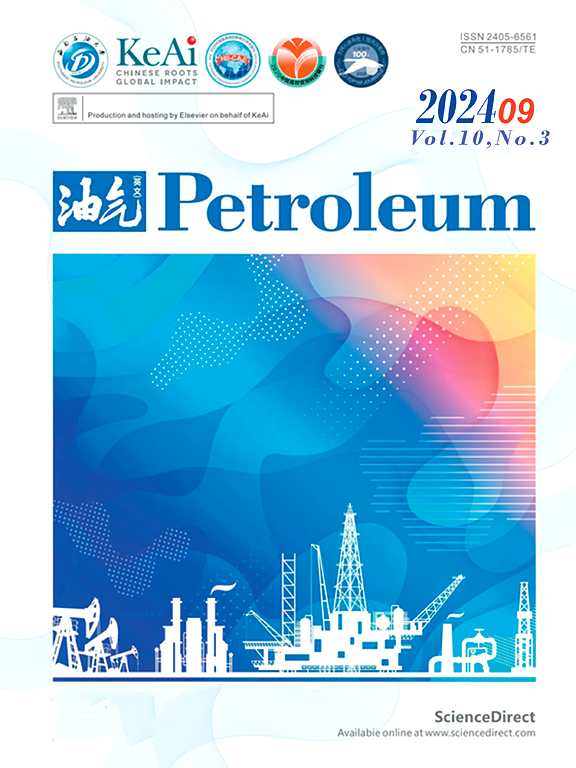Optimizing heavy crude oil conversion: Catalytic thermolysis with TiO2@α-Fe2O3 nanocomposite and surfactant dynamics
IF 4.2
Q2 ENERGY & FUELS
引用次数: 0
Abstract
Currently, as the production of light crude oil is reaching its peak, the focus of the petroleum industry is shifting towards significant amount of heavy oil to meet the increasing need for energy and fuels. Heavy oil is typically categorized by its high density, great viscosity with small API gravity, high hetero-atom content and limited low boiling point fuel fraction yield compared to light oil. One approach for enhancing the flow characteristics of heavy oil before the recovery process is introducing catalysts into the reservoir. This scientific research focuses on the preparation and characterization of (10%, 20%, 30%) TiO2@α-Fe2O3 nanocomposite catalysts for potential catalytic applications. The study outlines the synthesis method used to create different ratios of as-prepared nanocomposites. It provides detailed characterization through various analytical techniques. The results highlight the successful formation of X% TiO2@α-Fe2O3 nanocomposites with well-defined structures and optimized properties for catalytic reactions. The study investigates the impact of this nanocomposite on the rheological characterizations of heavy crude oil, focusing on the capability of decreasing viscosity and advance flow characteristics. The experimental results demonstrate notable improvements in viscosity reduction and enhancing heavy crude oil production processes as the best results obtained by (0.5 wt%) 20% TiO2@α-Fe2O3 (62.6% after 2 h at 200 °C). The asphaltene and resin ratio decreased by 54.5% and 68.1% respectively. The saturated and aromatic content shows 67.56% and 15.91% respectively at the same conditions. The presence of different surfactants (non-ionic and anionic) gives a synergetic effect which reveals active participation of contact angle changing and Interfacial tension (IFT) reduction. This research contributes to the advancement of methods for upgrading heavy crude oil, offering a promising avenue for increasing efficiency and productivity in the oil industry.

重质原油转化优化:TiO2@α-Fe2O3纳米复合材料催化热解及表面活性剂动力学
目前,随着轻质原油的产量达到峰值,石油工业的重点正在转向大量的重油,以满足日益增长的能源和燃料需求。与轻质油相比,重油通常具有密度高、粘度大、API比重小、杂原子含量高和低沸点燃料馏分收率有限等特点。在采油前提高稠油流动特性的一种方法是在储层中引入催化剂。本科学研究的重点是(10%,20%,30%)TiO2@α-Fe2O3纳米复合催化剂的制备和表征。该研究概述了用于制造不同比例的纳米复合材料的合成方法。它通过各种分析技术提供了详细的表征。结果表明,X% TiO2@α-Fe2O3纳米复合材料的成功形成具有明确的结构和优化的催化反应性能。该研究考察了这种纳米复合材料对重质原油流变特性的影响,重点研究了其降低粘度和改善流动特性的能力。实验结果表明,(0.5 wt%) 20% TiO2@α-Fe2O3(在200℃下作用2 h后达到62.6%)对降低稠油粘度和提高稠油收率有显著的改善作用。沥青质比和树脂比分别下降54.5%和68.1%。在相同条件下,饱和和芳香含量分别为67.56%和15.91%。不同表面活性剂(非离子和阴离子)的存在产生了协同效应,显示了接触角改变和界面张力(IFT)降低的积极参与。该研究有助于提高重质原油的改造方法,为提高石油工业的效率和生产力提供了一条有前途的途径。
本文章由计算机程序翻译,如有差异,请以英文原文为准。
求助全文
约1分钟内获得全文
求助全文
来源期刊

Petroleum
Earth and Planetary Sciences-Geology
CiteScore
9.20
自引率
0.00%
发文量
76
审稿时长
124 days
期刊介绍:
Examples of appropriate topical areas that will be considered include the following: 1.comprehensive research on oil and gas reservoir (reservoir geology): -geological basis of oil and gas reservoirs -reservoir geochemistry -reservoir formation mechanism -reservoir identification methods and techniques 2.kinetics of oil and gas basins and analyses of potential oil and gas resources: -fine description factors of hydrocarbon accumulation -mechanism analysis on recovery and dynamic accumulation process -relationship between accumulation factors and the accumulation process -analysis of oil and gas potential resource 3.theories and methods for complex reservoir geophysical prospecting: -geophysical basis of deep geologic structures and background of hydrocarbon occurrence -geophysical prediction of deep and complex reservoirs -physical test analyses and numerical simulations of reservoir rocks -anisotropic medium seismic imaging theory and new technology for multiwave seismic exploration -o theories and methods for reservoir fluid geophysical identification and prediction 4.theories, methods, technology, and design for complex reservoir development: -reservoir percolation theory and application technology -field development theories and methods -theory and technology for enhancing recovery efficiency 5.working liquid for oil and gas wells and reservoir protection technology: -working chemicals and mechanics for oil and gas wells -reservoir protection technology 6.new techniques and technologies for oil and gas drilling and production: -under-balanced drilling/gas drilling -special-track well drilling -cementing and completion of oil and gas wells -engineering safety applications for oil and gas wells -new technology of fracture acidizing
 求助内容:
求助内容: 应助结果提醒方式:
应助结果提醒方式:


